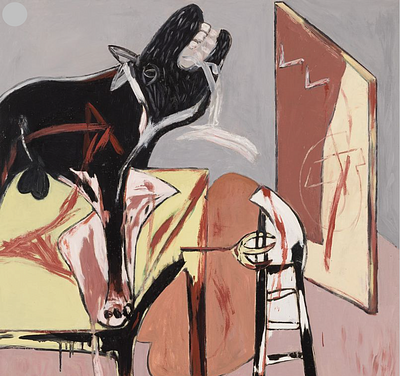JUAN MANUEL DIAZ CANEJA (Palencia, 1905 - Madrid, 1988). "Landscape and houses", 1974 Mixed media and oil on canvas.
Lot 71
About Seller
Setdart Auction House
Carrer Aragó 346
Barcelona
Spain
Setdart Subastas was born in 2004 and is currently the first online art auction in Spain with solidity, prestige and reliability guaranteed by our more than 60,000 users. Setdart has a young, dynamic and enterprising team ready to successfully manage the purchase and sale of art works through custom...Read more
Categories
Estimate:
EUR€8,000 - EUR€10,000
$8,247.42 - $10,309.28
Absentee vs Live bid
Two ways to bid:
- Leave a max absentee bid and the platform will bid on your behalf up to your maximum bid during the live auction.
- Bid live during the auction and your bids will be submitted real-time to the auctioneer.
Bid Increments
| Price | Bid Increment |
|---|---|
| EUR€0 | EUR€10 |
| EUR€200 | EUR€25 |
| EUR€500 | EUR€50 |
| EUR€1,000 | EUR€100 |
| EUR€3,000 | EUR€200 |
| EUR€5,000 | EUR€500 |
| EUR€10,000 | EUR€1,000 |
| EUR€20,000 | EUR€2,000 |
| EUR€50,000 | EUR€5,000 |
About Auction
By Setdart Auction House
Nov 16, 2021
Set Reminder
2021-11-16 08:00:00
2021-11-16 08:00:00
America/New_York
Bidsquare
Bidsquare : Contemporary and Actual Art
https://www.bidsquare.com/auctions/setdart-auction-house/contemporary-and-actual-art-7839
Setdart Auction House sofia@setdart.com
Setdart Auction House sofia@setdart.com
- Lot Description
JUAN MANUEL DIAZ CANEJA (Palencia, 1905 - Madrid, 1988). "Landscape and houses", 1974 Mixed media and oil on canvas. Signed in the lower left corner. Signed and dated on the back. Measurements: 61 x 50 cm; 66 x 54.5 cm (frame). This work shows a landscape through an aesthetic close to abstraction and purity of forms, a usual and characteristic element in the works of Juan Manuel Díaz Caneja, shown with a fine avant-garde vision that stands out for a certain elegance and intimacy transmitted thanks to a series of subtle variations in volumes, line and tonalities. From the 1970s onwards, his work became increasingly focused on the landscape, taking it as an autonomous space reduced to the minimum elements. Juan Manuel Díaz Caneja was a cubist painter, known and appreciated, above all, for his settings in the Castilian landscape. In 1923 he began his university studies in architecture in Madrid, and attended classes in the studio of Daniel Vázquez Díaz to prepare for the subject of drawing. He soon discovered his passion, and left his studies to devote himself to painting. He actively participated in the avant-garde cultural life, especially while living in the Residencia de Estudiantes in the capital. In 1927 he met the members of the Vallecas School Benjamín Palencia and Alberto Sánchez Pérez. He saw and studied Cubism first hand when he spent the winter of 1929 in Paris. In 1930 he settled in Zaragoza, where he shared a studio with Manuel Corrales and González Bernal. A year later, in Madrid, he published with Herrera Perete an anarchist, Dadaist and surrealist magazine called "En España ya todo está preparado para que se enamoren los sacerdotes", and began his long list of exhibitions with his first individual exhibition three years later. After meeting his future partner Isabel Fernández Almansa, he joined the Communist Party of Spain, an affiliation he would maintain throughout his life, and joined the National Confederation of Labor. He served on the Republican side during the Civil War, at the end of which he lived and worked in Madrid. In order to avoid censorship, his main theme was landscape, for which he would become so well known. He was arrested and imprisoned in 1948 for his links with the Republicans, spending three years in prisons (Carabanchel and Ocaña), without ever stopping painting. His work was, however, recognized with several awards (National Painting Prize in 1958; First Medal in the National Exhibition of Fine Arts in 1962; National Prize of Plastic Arts of Spain in 1980; Castilla y León Prize of Arts in 1984) and with the creation in Palencia, in 1995, of a foundation with his name, which has its headquarters in the Museum of Contemporary Art of this city. His work has been exhibited in Madrid, Santander, Bilbao, Paris, Copenhagen, Zaragoza, Pamplona, León, Valladolid, Rome, etc., and is kept in important private collections all over the world and in important institutions (his aforementioned foundation, the Museo Centro de Arte Reina Sofía in Madrid, the Guggenheim Museum in New York, the Museo Patio Herreriano in Valladolid, the Museo de Bellas Artes in Bilbao, etc.).
- Shipping Info
-
In-house shipping available. Please inquire at admin@setdart.com.
-
- Buyer's Premium



 EUR
EUR CAD
CAD AUD
AUD GBP
GBP MXN
MXN HKD
HKD CNY
CNY MYR
MYR SEK
SEK SGD
SGD CHF
CHF THB
THB















